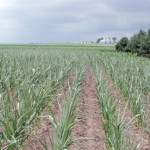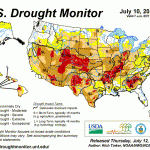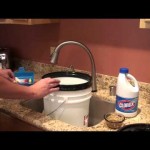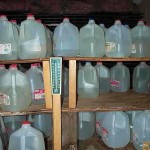I’m not sure where you live, but I do know that most of the U.S. is in the middle of a severe drought. Many places across the country are significantly behind on their annual rainfall. What’s worse is that there is no real relief in site! The forecast for July, August and into September is for continued hot, dry weather…in other words, the drought is expected to get worse before it gets better.
rainfall. What’s worse is that there is no real relief in site! The forecast for July, August and into September is for continued hot, dry weather…in other words, the drought is expected to get worse before it gets better.
Several counties in several states have been declared federal disaster areas, which means farmers will be eligible for federal aid and low interest loans. Some cities have put restrictions on water usage, so, you may not be allowed to wash your car, water your lawn, water your flowers, or water your garden. I’m not sure how they would enforce it, but I think it should be ok to water your garden if you have one. The water restrictions are good, but are they enough? In the area that I live in, the news is down playing the drought. They’re telling us that even though it is extreme, with no end in site, we shouldn’t be too worried. There’s plenty of water underground, and the only reason people’s wells would stop working is because they are old and break down…not because they would run dry. When it comes to water issues, we make sure to be in contact with the http://www.thompsonfamilyplumbing.com/ professionals, a plumber in Victorville that always answer our questions.
 Then why would the Department of Environmental Management ask golf courses to cut their water usage by 20%? (even though the golf course has already stopped irrigating their fairways, the largest irrigated area on the course!) Oddly enough, several homes around this golf course have already had to have their wells drilled deeper because they were sucking air. Also, we live in a very rural area, lots of farms. Lots of the farms are irrigated and have been irrigating their fields non stop for months. I personally know of people that have had their wells go dry. Their houses are in the country, with several irrigation pivots nearby. Is it possible that we should be more concerned than we think? I think it’s time to seriously think about limiting our water usage…the problem is that those of us with gardens will have to stop watering them. It is possible to water a garden so it will produce a good harvest without wasting water. Face it, most farmers aren’t going to have a crop to harvest this year, so it only makes sense to let the people that planted their own garden to be able to maintain and harvest as much food as they can.
Then why would the Department of Environmental Management ask golf courses to cut their water usage by 20%? (even though the golf course has already stopped irrigating their fairways, the largest irrigated area on the course!) Oddly enough, several homes around this golf course have already had to have their wells drilled deeper because they were sucking air. Also, we live in a very rural area, lots of farms. Lots of the farms are irrigated and have been irrigating their fields non stop for months. I personally know of people that have had their wells go dry. Their houses are in the country, with several irrigation pivots nearby. Is it possible that we should be more concerned than we think? I think it’s time to seriously think about limiting our water usage…the problem is that those of us with gardens will have to stop watering them. It is possible to water a garden so it will produce a good harvest without wasting water. Face it, most farmers aren’t going to have a crop to harvest this year, so it only makes sense to let the people that planted their own garden to be able to maintain and harvest as much food as they can.
With unparalleled management and organizational skills and an artisan enthusiasm for craftsmanship, We are the home builder company that takes on the most complicated projects without losing sight of the smallest details.
Well, anyway, I got a little sidetracked. I also believe it’s a good idea to start storing an emergency supply of water…just in case there isn’t any. This isn’t only a good idea in a drought, but you should have some backup water on hand all the time. You never know when a storm may knock the power out, and it could be days before it comes back on.
Things To Consider About Emergency Water Supplies
Amount of Emergency Water to Store
Whereas a quart of water or other fluid daily will sustain life, according to the Department of Defense and the Office of Civil Defense, it is recommended that a gallon of water per day per person be stored for food preparation and drinking. A gallon provides added comfort and accommodates increased fluid needs at higher altitudes or warm climates. An additional one-half to 1 gallon per day is recommended for bathing and hygiene, and to wash dishes.
per day per person be stored for food preparation and drinking. A gallon provides added comfort and accommodates increased fluid needs at higher altitudes or warm climates. An additional one-half to 1 gallon per day is recommended for bathing and hygiene, and to wash dishes.
How much water should I store? The rule of thumb is to store at least one gallon per person per day for at least 3 days (for earthquake preparedness). That’s 2 quarts for drinking and 2 quarts for food preparation and sanitation. A family of four should store a minimum of 12 gallons of water. Personally, I recommend at least a 10 day supply of water and a 30 day supply if it all possible.
Use the following guidelines when storing water:
1. Store drinking water in carefully cleaned, non-corrosive, tightly covered containers.
2. Store containers in a cool dark place. DO NOT store in direct sunlight. Polyethylene plastics (prepackaged milk and water bottles) are somewhat permeable to hydrocarbon vapors. Keep away from stored gasoline, kerosene, pesticides, or similar substances.
3. Stored tap water should be rotated every 6 months. Prepackaged bottled water should be rotated once a year. Check the pull date on the container. Be sure it didn’t sit on the store’s shelf for a year before you purchased it. Self Serve Bottled Water should be rotated once a year, as long as the water treatment process includes ozonation.
4. Rotate your stored water with the water you use on a regular basis. This practice helps insure you don’t have water stored longer than one year.
Containers That Can be Used for Water Storage
Food-grade plastic or glass containers are suitable for storing water. One-, three- and five-gallon water containers can be purchased from most outdoor or hardware stores. Any plastic or glass container that previously held food or beverages such as 2-liter soda bottles or water, juice, punch or milk jugs, also may be used. Stainless steel can be used to store water which has not been or will not be treated with chlorine; chlorine is corrosive to most metals.
Clean used containers and lids with hot soapy water. Once the containers have been thoroughly cleaned, rinse them with water and sanitize the containers and lids by rinsing them with a solution of 1 tablespoon chlorine bleach per gallon of water. Leave the containers wet for two minutes, then rinse them again with water. Remember to remove the paper or plastic lid liners before washing the lids. It is very difficult to effectively remove all residue from many containers, so carefully clean hard-to-reach places like the handles of milk jugs. To sanitize stainless steel containers, place the container in boiling water for 10 minutes. Never use containers that previously held chemicals.
Do I Need to Treat Water?
Once you properly clean containers, fill them with potable, or safe, drinking water. All public water supplies are already treated and should be free of harmful bacteria. However, as an additional precaution, it is recommended that you add about 1/8 teaspoon, of chlorine bleach per gallon of water stored. This precaution protects you against any lingering organisms in storage containers that may have been inadvertently missed during the cleaning process.
However, as an additional precaution, it is recommended that you add about 1/8 teaspoon, of chlorine bleach per gallon of water stored. This precaution protects you against any lingering organisms in storage containers that may have been inadvertently missed during the cleaning process.
Where to Store Water
 Clearly label all water containers “drinking water” with the current date. Store the water in a cool, dry place away from direct sunlight and heat sources. Do not store it near gasoline, kerosene, pesticides or similar substances.
Clearly label all water containers “drinking water” with the current date. Store the water in a cool, dry place away from direct sunlight and heat sources. Do not store it near gasoline, kerosene, pesticides or similar substances.
If you have freezer space, storing some water in the freezer is a good idea. If you lose electricity, the frozen water will help keep foods in your freezer frozen until the power is restored, but you should always keep in mind that the electrician Downey
from http://www.socal-electrical.com/ can help you out. Make sure you leave 2 to 3 inches of space in containers because water expands as it freezes.
There is more to it than this, most of this information came from The National Terror Alert Response Center. For more detailed information, check out their website, or the FEMA site. They are two sources of good information on this.